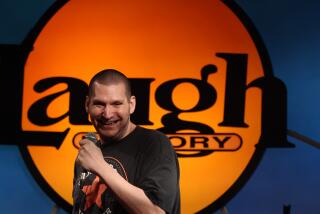BOOK REVIEW : A Mother Battles Time and Convention to Heal Her Children : LET ME HEAR YOUR VOICE: A Familyâs Triumph Over Autism <i> by Catherine Maurice</i> ; Knopf $24, 384 pages
For a reviewer, the first glimmer of the passion that burns hot and bright in âLet Me Hear Your Voiceâ comes in the form of a remarkable note from the editor of the book: Do not assign the book for review, the editor asks, to anyone in âthe autism world.â
The author of âLet Me Hear Your Voiceâ is the mother of two autistic children, and the book offers the troubling but ultimately inspiring story of how her family succeeded in treating the disorder by means of the behavioral modification techniques pioneered by UCLA psychologist O. Ivar Lovaas.
âThis therapy is bitterly opposed by those in the autism world whose therapeutic approach is based on psychoanalytic theories,â wrote Corona Machemer in a note to book review editors. âI hope you will consider sending it to a child development expert or layperson outside the autism field.â
The story of one womanâs struggle to save her children from autism begins with the awful moments when Catherine Maurice (a pseudonym) first began to notice that her daughter, Anne-Marie, was different from her older brother in subtle but disquieting ways.
âWho knows, really, what the first sign was, at what point Anne-Marie began to slip quietly away from us,â Maurice muses. âProblem here? . . . something wrong? . . . those splayed fingers, that odd employment of thumb and pinky, looked so . . . so . . . bizarre. â
As the symptoms became more pronounced--âtoe-walkingâ and âhand-flappingâ and teeth-grinding and, worst of all, strange repetitive rituals that drew Anne-Marie into her own world--Maurice discovered that there was a term to describe Anne-Marieâs affliction: she was autistic, and, as it later turned out, so was their third child, Michel.
âI was in a race against time, and either I found someone or something that truly helped or I had lost Anne-Marie forever,â she writes. âAutism is an impossible condition of being there and not being there; a person without a self; a life without a soul.â
And Maurice discovered, too, that the search for a successful treatment was an ordeal in itself. She encountered arrogance, bias, insensitivity, âwindy verbosityâ and plain wrongheadedness in the very men and women to whom she turned for salvation.
âDay by day we grew more âexpertâ in autism, yet paradoxically grew more helpless,â writes Maurice. âBut it became evident to me early on that the âexpertsâ I was consulting didnât know a whole lot more than I did.â
Like all distraught parents of afflicted children, Maurice sought out the healers who might rescue her children: play therapists and âholdingâ therapists and âtherapeuticâ nursery schools, social workers and educational development specialists, psychologists and psychiatrists. She read, she studied, she prayed. And, fatefully, she found her way to a UCLA researcher named Lovaas who believed that intensive behavioral therapy--rather than pharmacological or psychoanalytic approaches--might ârecoverâ a child from autism.
Maurice was drawn to the primal appeal of âholdingâ therapy, which encourages the parent to âre-bondâ with the autistic child by the simple act of hugging, but she recoiled at the psychoanalytic premise on which it was based--the notion the autism is the fault of the mother who has withdrawn from her child.
âThe consensus among experts had been that autism was caused by--now who would have guessed it?--mommy!â she writes of the theory that once held sway over the treatment of autism. âAlong with schizophrenia, mass murder, hyperactivity, and manic depression, it was only logical that mommies should take the rap for autism, thanks to the ever-vigilant and feverish Freudians.â
What really worked for Anne-Marie and Michel were the here-and-now, one-on-one techniques of Lovaas, who teaches that autistic children can be helped by reinforcing the basic skills of language, movement and behavior through reward and repetition.
The use of behavior modification techniques--rewarding the child with M&Ms; or a few words of praise for making eye contact or sitting upright in a chair--is hotly controversial within the âthe autism world,â as Maurice and her editor readily concede, but the book is a measured endorsement of these techniques. And, after all, who is a more credible advocate than a mother whose children were redeemed from the âdeath in lifeâ that is autism?
As Maurice puts it, the truth consists in âlearning how to take what worked, how to learn from those who could teach us, and how, finally, to trust our own instincts and reason.â
In the end, no mere book review--indeed, no single book--will resolve the controversies that continue to spark around autism. But âLet Me Hear Your Voiceâ is a convincing argument for the proposition that healing may come in surprising ways and from unexpected sources.
More to Read
Sign up for our Book Club newsletter
Get the latest news, events and more from the Los Angeles Times Book Club, and help us get L.A. reading and talking.
You may occasionally receive promotional content from the Los Angeles Times.








